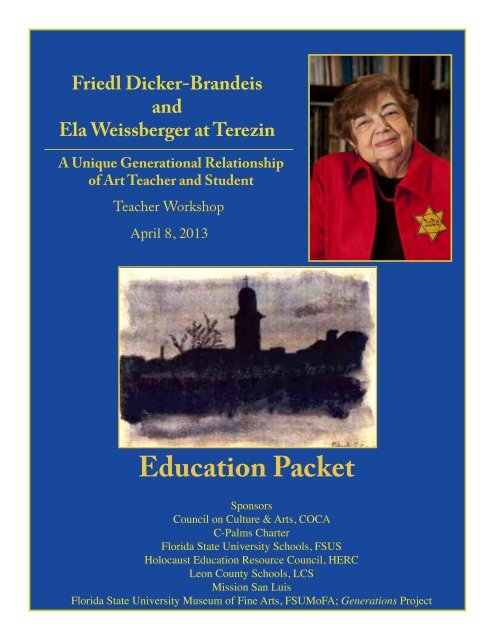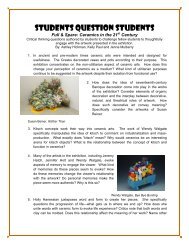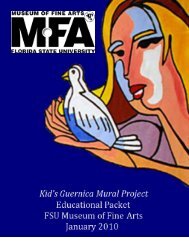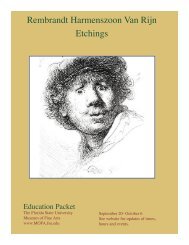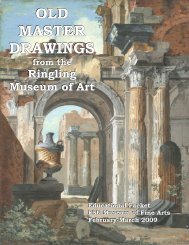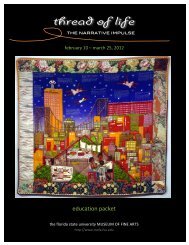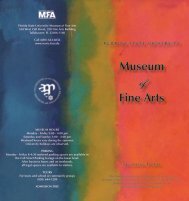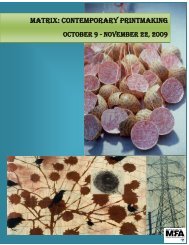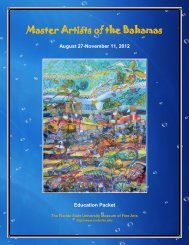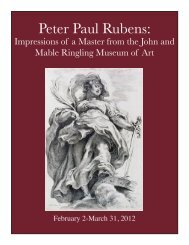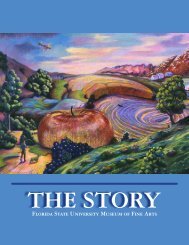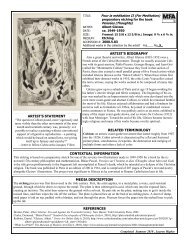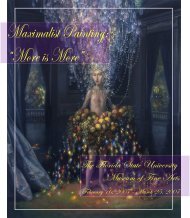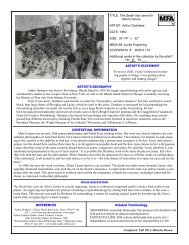Friedl Dicker-Brandeis and Ela Weissberger at Terezin
Friedl Dicker-Brandeis and Ela Weissberger at Terezin
Friedl Dicker-Brandeis and Ela Weissberger at Terezin
- No tags were found...
You also want an ePaper? Increase the reach of your titles
YUMPU automatically turns print PDFs into web optimized ePapers that Google loves.
<strong>Friedl</strong> <strong>Dicker</strong>-<strong>Br<strong>and</strong>eis</strong><strong>and</strong><strong>Ela</strong> <strong>Weissberger</strong> <strong>at</strong> <strong>Terezin</strong>A Unique Gener<strong>at</strong>ional Rel<strong>at</strong>ionshipof Art Teacher <strong>and</strong> StudentTeacher WorkshopApril 8, 2013Educ<strong>at</strong>ion PacketSponsorsCouncil on Culture & Arts, COCAC-Palms CharterFlorida St<strong>at</strong>e University Schools, FSUSHolocaust Educ<strong>at</strong>ion Resource Council, HERCLeon County Schools, LCSMission San LuisFlorida St<strong>at</strong>e University Museum of Fine Arts, FSUMoFA; Gener<strong>at</strong>ions Project
Table of ContentsSunshine St<strong>at</strong>e St<strong>and</strong>ards & Holocaust Educ<strong>at</strong>ion M<strong>and</strong><strong>at</strong>e....................................................................................2-3Biographies<strong>Friedl</strong> <strong>Dicker</strong>-<strong>Br<strong>and</strong>eis</strong>: Teaching More Than Art......................................................................................4<strong>Ela</strong> <strong>Weissberger</strong>: Never Give Up................................................................................................................5<strong>Ela</strong> <strong>Weissberger</strong>The Influence of <strong>Friedl</strong> <strong>Dicker</strong>-<strong>Br<strong>and</strong>eis</strong> <strong>at</strong> <strong>Terezin</strong>…………...................................................................6Brundibar…………....................................................................................................................................7Activities for StudentsTechnique <strong>at</strong> <strong>Terezin</strong>...................................................................................................................................8-9Draw <strong>and</strong> Paint Wh<strong>at</strong> You See...................................................................................................................10-11Descriptive Poetry…..................................................................................................................................12-13Draw Wh<strong>at</strong> You See: Something Beautiful................................................................................................14-15Draw Wh<strong>at</strong> You See: Wh<strong>at</strong>’s Your Legacy? Family Values....………………………........................…...16-17Capturing a Sentiment: Notecards With a Universal Message………….....................................………..18-19RubricsGeneral Activity Rubric..............................................................................................................................20Rubric for Draw Wh<strong>at</strong> You See: Something Beautiful & Wh<strong>at</strong>’s Your Legacy? Family Values................21Rubrics for Capturing a Sentiment: Notecards with a Universal Message….............................................22-23AppendixGlossary.......................................................................................................................................................24Content <strong>and</strong> Image Sources.........................................................................................................................25Evalu<strong>at</strong>ion....................................................................................................................................................26Resource Disk.............................................................................................................................................Attached*All images in this packet are for one time educ<strong>at</strong>ional use only.Written <strong>and</strong> edited by Brooke Shaw <strong>and</strong> Valerie deLeonIn conjunction with the “Gener<strong>at</strong>ions” exhibit, refer to the back of packet for details.Cover Images: <strong>Ela</strong> <strong>Weissberger</strong> by Laura McNamara, 2011, photograph.Dita Polachová-Kraus, Building <strong>at</strong> Night, charcoal, Child <strong>at</strong> <strong>Terezin</strong>.
Big Idea: Skills, Techniques, <strong>and</strong> ProcessesEnduring Underst<strong>and</strong>ing: Through purposeful practice, artists learn to manage, master, <strong>and</strong> refine simple, then complex,skills <strong>and</strong> techniques.VA.912.S.3.5 Cre<strong>at</strong>e multiple works th<strong>at</strong> demonstr<strong>at</strong>e thorough explor<strong>at</strong>ion of subject m<strong>at</strong>ter <strong>and</strong> themes.VA.912.S.3.6 Develop works with prominent personal vision revealed through mastery of art tasks <strong>and</strong> tools.Common Core St<strong>at</strong>e St<strong>and</strong>ardsSecondary Level CCSS.English Language Arts & Literacy (ELA): Integr<strong>at</strong>e <strong>and</strong> evalu<strong>at</strong>e content presented indiverse media <strong>and</strong> form<strong>at</strong>s, including visually <strong>and</strong> quantit<strong>at</strong>ively, as well as in words.Holocaust Educ<strong>at</strong>ion M<strong>and</strong><strong>at</strong>eStudents will pursue an investig<strong>at</strong>ion of human behavior, an underst<strong>and</strong>ing of the ramific<strong>at</strong>ions of prejudice, racism,<strong>and</strong> stereotyping, <strong>and</strong> an examin<strong>at</strong>ion of wh<strong>at</strong> it means to be a responsible <strong>and</strong> respectful person, for the purposes ofencouraging tolerance of diversity in a pluralistic society, <strong>and</strong> for nurturing <strong>and</strong> protecting democr<strong>at</strong>ic value <strong>and</strong> institutions.L<strong>and</strong>scape, W<strong>at</strong>ercolor, Child <strong>at</strong> <strong>Terezin</strong>3
The Influence of <strong>Friedl</strong> <strong>Dicker</strong>-<strong>Br<strong>and</strong>eis</strong><strong>at</strong> <strong>Terezin</strong><strong>Terezin</strong> was portrayed to the outside world as a peaceful community where the adults worked diligently <strong>and</strong>the children played all day long. Only the inhabitants of <strong>Terezin</strong> <strong>and</strong> the Nazi comm<strong>and</strong>ers knew of its harsh reality– executions, overcrowded barracks, stale food, bed bugs, shortage of clothes <strong>and</strong> blankets, as well as spreadingsickness. Despite these conditions, <strong>Friedl</strong> <strong>Dicker</strong>-<strong>Br<strong>and</strong>eis</strong> tried to provide a cre<strong>at</strong>ive outlet for children in the camp,to grant them some form of familiarity with normal life through her art classes. In the camps, art instruction or anycultural g<strong>at</strong>herings were forbidden. To maintain their secret classes, students would meet in the <strong>at</strong>tics of the barracks<strong>and</strong> <strong>Friedl</strong> would hide the artworks in her suitcases. Despite the limited m<strong>at</strong>erials, <strong>Friedl</strong> made it a point to “borrow”scraps of paper from the German officers to utilize as the children’s canvases.The subject m<strong>at</strong>ter for the pieces varied from actual events in the camp to copies of the old masters from<strong>Friedl</strong>’s art history books. Since the camp was the students’ constant environment, somber scenes of the architecture,sickness <strong>and</strong> de<strong>at</strong>h prevailed. Cut paper collages were a popular medium used to portray the three-tiered bunks inwhich people had to sleep or to cre<strong>at</strong>e interpret<strong>at</strong>ions of Vermeer’s paintings. W<strong>at</strong>ercolor <strong>and</strong> charcoal were less prevalent,yet some students used the media to illustr<strong>at</strong>e the eerie l<strong>and</strong>scapes th<strong>at</strong> surrounded them, depicting silhouettesof buildings, or to illustr<strong>at</strong>e memories or yearnings for their home villages. Others used the artwork as a sense of reliefor hope. Some children sketched out characters th<strong>at</strong> were fe<strong>at</strong>ured in the children’s opera Brundibar, an opera th<strong>at</strong>was staged <strong>at</strong> <strong>Terezin</strong> by the prisoners. Others cre<strong>at</strong>ed birthday cards or home memories to give as gifts to loved ones.Through the fear, sickness <strong>and</strong> de<strong>at</strong>h, <strong>Friedl</strong> <strong>Dicker</strong>-<strong>Br<strong>and</strong>eis</strong> provided a means for expression of feelings. Art allowedthe children, through the freedom to draw, the cre<strong>at</strong>ion of a world where oppression lessened <strong>and</strong> hope remained.Prisoners Sleeping, Drawing, Child <strong>at</strong> <strong>Terezin</strong>6
BrundibarIn the l<strong>at</strong>e 1930s, the German regime began to gain power. Tensions increased <strong>and</strong> displacement occurred, especiallyfor those of Jewish descent. Many people cre<strong>at</strong>ed plays, artwork, or songs to deal with fear of the unknown. InPrague, two composers cre<strong>at</strong>ed a children’s opera th<strong>at</strong> revolved around issues th<strong>at</strong> pressured <strong>and</strong> oppressed the Jewishcommunity before <strong>and</strong> during World War II.The opera, Brundibar, was the story of two children who needed to buy milk for their sick mother. An organ playerby the name of Brundibar played music to earn money, inspiring the children to do the same. Aninka <strong>and</strong> Pepicek tried tosing in the square but failed to c<strong>at</strong>ch the <strong>at</strong>tention of those th<strong>at</strong> passed by. They discovered they needed to sing louder to<strong>at</strong>tract the crowd. With the help of a dog, c<strong>at</strong>, sparrow <strong>and</strong> supportive children of the town they began to make money bycre<strong>at</strong>ing a large choir. Envious th<strong>at</strong> the children were doing so well, Brundibar stole the cap containing their earnings. Hisplan turned sour when he was surrounded by the children <strong>and</strong> animals, cre<strong>at</strong>ing yet another victory for them. The children’ssongs in the opera thus became a symbol of hope <strong>and</strong> friendship.Although this opera symbolized Hitler’s abuse of the Jews, the children <strong>at</strong> the <strong>Terezin</strong> concentr<strong>at</strong>ion camp wereable to present it. Usually plays, songs or cultural g<strong>at</strong>herings were forbidden to those in the camps. Rehearsals <strong>and</strong> performancesoccurred under cl<strong>and</strong>estine circumstances. Interestingly when rumors spread across the world th<strong>at</strong> the Naziswere killing Jews <strong>at</strong> these camps by the thous<strong>and</strong>s, the Nazis supported a performance of Brundibar for the Red Cross. Tocounteract the rumors, the Nazis put together a film/documentary to show the “real life” in a concentr<strong>at</strong>ion camp, falselymaking <strong>Terezin</strong> appear as a peaceful community where people were free to play, work, <strong>and</strong> perform in concerts such asBrundibar. Brundibar became the center of this Nazi propag<strong>and</strong>a but many performers were sent to die <strong>at</strong> Auschwitz afterthis production.To the outside world, the opera was a signifier th<strong>at</strong> all was well in the camps but the performers knew its true intent.Despite the false advertisement provided by Brundibar, the opera held a special meaning to those in the cast. Survivor<strong>Ela</strong> <strong>Weissberger</strong> who played the c<strong>at</strong> exclaimed, “We were in a dream world,” where the children could escape the harshreality of <strong>Terezin</strong> <strong>and</strong> impending transport<strong>at</strong>ion to Auschwitz. While performing, they did not have to wear the yellow starof David <strong>and</strong> could dress up in costumes for their characters. To the children, the opera was a beacon of hope th<strong>at</strong> burnedbrightly every time it was staged. Hitler to them was Brundibar <strong>and</strong> the performance instilled a renewed faith th<strong>at</strong> theywould one day leave <strong>Terezin</strong> <strong>and</strong> return to their homes.Cast of Children in Brundibar <strong>at</strong> <strong>Terezin</strong>7
Activity Procedure:1. Introduce a small selection of very famous paintings <strong>and</strong> briefly discuss their importance to art history (in h<strong>and</strong>outs).A. Describe technical innov<strong>at</strong>ions these paintings contributed to art.B. Discuss the way these paintings influenced other artworks.C. Discuss the way artists in training are sometimes allowed, even today, to go to museums to make copiesof old master works. Show an image of such an artist, if possible. See examples below.2. Present artworks cre<strong>at</strong>ed by children <strong>at</strong> <strong>Terezin</strong> based on master paintings (p. 17 in Fireflies in the Dark).A. Ask the way the children’s pieces reflected the master works.B. Ask the students to describe the colors <strong>and</strong> shapes used by the <strong>Terezin</strong> students.C. Ask the students to describe the background papers used by <strong>Friedl</strong>’s students.D. Tell the students about the children <strong>at</strong> <strong>Terezin</strong> <strong>and</strong> their lack of m<strong>at</strong>erials. Explain th<strong>at</strong> lack of m<strong>at</strong>erialsdid not stop them.3. Give the students a selection of old master paintings on which to base their recre<strong>at</strong>ions with basic label inform<strong>at</strong>ion foreach. Have each student choose an artwork, two colors of construction paper <strong>and</strong> a background paper. Each will make acollage using the techniques displayed in the <strong>Terezin</strong> works.4. After everyone has finished, display the works. Ask the students wh<strong>at</strong> paintings they chose to use <strong>and</strong> why. Ask thestudents to talk about the challenge of cre<strong>at</strong>ing the images with only cut paper shapes <strong>and</strong> blocks of two colors as opposedto paint <strong>and</strong> multiple colors. Reflecting on the challenging <strong>at</strong>tributes of the activity will allow the students to get a sense ofthe determin<strong>at</strong>ion of the children <strong>at</strong> <strong>Terezin</strong>.5. Evalu<strong>at</strong>ion: See General Activity Rubric on pg 20. You can adapt the rubric to this lesson plan as necessary.Artists Copying Old Master Work, Left: Johannes Vermeer, The Artof Painting, 1622-68, oil on canvas. Right: Johannes Vermeer, YoungWoman with a W<strong>at</strong>er Pitcher, 1622-65, oil on canvas.9
Draw <strong>and</strong> Paint Wh<strong>at</strong> You SeeBy: Brooke Shaw <strong>and</strong> Valerie deLeonEnduring Idea:Through art, neg<strong>at</strong>ive human behaviors <strong>and</strong> their effects (prejudice, racism, <strong>and</strong> stereotyping) <strong>and</strong> positivehuman behavior <strong>and</strong> their effects (a sense of responsibility, as well as respect for others <strong>and</strong> their values) can <strong>and</strong> mustbe analyzed in order to promote, preserve, <strong>and</strong> perpetu<strong>at</strong>e tolerance <strong>and</strong> democr<strong>at</strong>ic culture.Essential Question:In wh<strong>at</strong> ways does an artist use the surrounding subject m<strong>at</strong>ter to cre<strong>at</strong>e art which conveys his/her emotions<strong>and</strong> thoughts. In wh<strong>at</strong> ways can this art relfect oppression <strong>and</strong> intoleance?Session Activity:In this activity students will focus on the idea of “draw wh<strong>at</strong> you see.” <strong>Friedl</strong> <strong>Dicker</strong>-<strong>Br<strong>and</strong>eis</strong> taught herstudents to look <strong>at</strong> the outside world <strong>and</strong> realistically portray it as seen. Begin by showing <strong>and</strong> discussing the settingsof <strong>Terezin</strong>, wh<strong>at</strong> the children would have seen, <strong>and</strong> display examples of their work.The illustr<strong>at</strong>ions sketched by the children depicted images of their daily life in the concentr<strong>at</strong>ion camp <strong>and</strong>hope th<strong>at</strong> they would someday leave those places. Many of the works were limited in color scheme, making moreemphasis on line <strong>and</strong> its thickness to suggest their feelings. Perhaps due to the secretive n<strong>at</strong>ure of their art lessons, theworks often appeared to be sketch-like <strong>and</strong> impressionistic.Discuss the emotions <strong>and</strong> thoughts the <strong>Terezin</strong> drawings <strong>and</strong> w<strong>at</strong>ercolors conveyed through the use of the artelements. For example, discuss the way the minimal colors <strong>and</strong> dark lines evoked a dreary loc<strong>at</strong>ion. After looking <strong>at</strong>their pieces, each person will work individually on his/her own drawings or w<strong>at</strong>ercolors.For this activity, each student will cre<strong>at</strong>e an image based on “draw wh<strong>at</strong> you see.” Students will focus on the elementsof art, on line, color, texture, shape, space, <strong>and</strong> value. Choose where to take the class, either inside the schoolor outside, <strong>and</strong> have them individually choose scenes to draw or paint with w<strong>at</strong>ercolor. Ask each student to write aparagraph about the scene he or she depicted, <strong>and</strong> the emotions <strong>and</strong> thoughts he or she tried to convey in the drawing.Each student will give his/her work a title.After the students finish their work, conduct a class discussion about each individual work. Ask the studentsto explain the reasons they chose those colors, th<strong>at</strong> loc<strong>at</strong>ion, <strong>and</strong> the way they think it comes across to their fellowclassm<strong>at</strong>es. Wh<strong>at</strong> part of the setting did each student depict? Do any of the students’ works look similar? In wh<strong>at</strong>ways do the elements of art help to achieve a represent<strong>at</strong>ion <strong>and</strong> convey thoughts or emotions? Select individualworks by students <strong>at</strong> <strong>Terezin</strong> to compare <strong>and</strong> contrastwith the works from the class, to compare <strong>and</strong>contrast “wh<strong>at</strong> each show.”Discuss the way each set of drawings – those from<strong>Terezin</strong> <strong>and</strong> those from the class – convey theartists’ emotions <strong>and</strong> thoughts, <strong>and</strong> convey theconcepts of oppression or tolerance.Grade Level: 7-12Time Needed: 2-3 class periodsCamp, Collage, Child <strong>at</strong> <strong>Terezin</strong>10
Objectives:1. Students will have a better underst<strong>and</strong>ing of the reasons the children <strong>at</strong> <strong>Terezin</strong> illustr<strong>at</strong>ed the l<strong>and</strong>scapes, characters <strong>and</strong>scenes in their pieces.2. Students will be able to reflect on their tre<strong>at</strong>ment of line <strong>and</strong> color in their own paintings <strong>and</strong> drawings.3. Students will underst<strong>and</strong> their surroundings can serve as an inspir<strong>at</strong>ion, <strong>and</strong> th<strong>at</strong> wh<strong>at</strong> they see can be transl<strong>at</strong>ed into artby the use of the art elements.4. Students will realize art can communic<strong>at</strong>e emotions <strong>and</strong> thoughts.5. Students will realize th<strong>at</strong> artwork can reflect oppression but can also reflect <strong>and</strong> emphasize tolerance.M<strong>at</strong>erials: Paper, pencils, w<strong>at</strong>ercolor paints, paper towels, cups, w<strong>at</strong>er, brushesActivity Procedure:1. After reading inform<strong>at</strong>ion about <strong>Friedl</strong> <strong>Dicker</strong>-<strong>Br<strong>and</strong>eis</strong> <strong>and</strong> <strong>Ela</strong> <strong>Weissberger</strong>, discuss the background of each <strong>and</strong> theirrel<strong>at</strong>ionship as teacher <strong>and</strong> student.2. Introduce <strong>Friedl</strong> <strong>Dicker</strong>-<strong>Br<strong>and</strong>eis</strong>’s lesson on “draw wh<strong>at</strong> you see,” <strong>and</strong> display examples of the children’s w<strong>at</strong>ercolors<strong>and</strong> sketches from <strong>Terezin</strong>. Discuss the way <strong>Terezin</strong> children’s drawings convey thoughts <strong>and</strong> emotions. Display a list ofthe art elements to which to refer during this discussion.3. Ask the following:A. Ask wh<strong>at</strong> they see in the images.B. Ask if the tre<strong>at</strong>ment of line <strong>and</strong> color adds or takes away from the pieces <strong>and</strong> how so?C. Ask wh<strong>at</strong> emotions the <strong>Terezin</strong> works make them feel <strong>and</strong> the way the children were feeling while making thepieces.4. Compare the images of the artwork to photos of the camp during th<strong>at</strong> time. Ask if the photos <strong>and</strong> the artwork have anyresemblances, if so then how?5. Have the class choose m<strong>at</strong>erials <strong>and</strong> set up the classroom, or go outside to begin working. Have each find one area inwhich to draw, <strong>and</strong> have each focus on portraying it realistically. Students will cre<strong>at</strong>e their own drawings or w<strong>at</strong>ercolorpaintings based on a scene. Ask them to think about using the art elements to help convey their thoughts <strong>and</strong> emotionsabout the subject m<strong>at</strong>ter. For example, reiter<strong>at</strong>e th<strong>at</strong> colors can be suggestive of something <strong>and</strong> th<strong>at</strong> the thickness/tre<strong>at</strong>mentof line can affect an image. Give each a list of the elements to keep on h<strong>and</strong> during the drawing/painting session.6. Ask each student to write a paragraph about the choice of scene <strong>and</strong> the emotions <strong>and</strong> thoughts he/she wished to convey.Ask the student to write the title of the work.7. After everyone has finished, the students will present their works to the class. Ask why each chose th<strong>at</strong> specific narr<strong>at</strong>ive<strong>and</strong> how each chose to illustr<strong>at</strong>e the scene. Have the students describe wh<strong>at</strong> techniques they chose <strong>and</strong> how the art elementshelped get their feelings across. Give them the opportunity to read their paragraphs.8. Sample Questions:a. Can you compare <strong>and</strong> contrast the surroundings in these images to those of the students <strong>at</strong> <strong>Terezin</strong>?b. Wh<strong>at</strong> fe<strong>at</strong>ures of the work from now show tolerance?c. Which fe<strong>at</strong>ures of the work from <strong>Terezin</strong> show oppression?d. Wh<strong>at</strong> in our time cre<strong>at</strong>es tolerance – in our class, in our school, in our country? Is this shown in the artworkcre<strong>at</strong>ed by the students in our classroom?e. Are there ways to show the encouragement of tolerance in these drawings/paintings?f. Wh<strong>at</strong> would you add or include in your work to encourage tolerance in the school environment or the societyas a whole?9. Evalu<strong>at</strong>ion: See General Activity Rubric on pg 20. You can adapt the rubric to this lesson plan as necessary.11
Descriptive PoetryBy: Brooke ShawEnduring Idea:Through art, neg<strong>at</strong>ive human behaviors <strong>and</strong> their effects (prejudice, racism, <strong>and</strong> stereotyping) <strong>and</strong> positivehuman behavior <strong>and</strong> their effects (a sense of responsibility, as well as respect for others <strong>and</strong> their values) can <strong>and</strong> mustbe analyzed in order to promote, preserve, <strong>and</strong> perpetu<strong>at</strong>e tolerance <strong>and</strong> democr<strong>at</strong>ic culture.Essential Question:In wh<strong>at</strong> ways can a person’s identity be maintained, expressed, <strong>and</strong> thus respected through cre<strong>at</strong>ive endeavor?Session Activity:This activity focuses on cre<strong>at</strong>ing poems th<strong>at</strong> exemplify the student’s identity. In this activity students willextend the idea of “draw wh<strong>at</strong> you see.” <strong>Friedl</strong> <strong>Dicker</strong>-<strong>Br<strong>and</strong>eis</strong>’s students cre<strong>at</strong>ed poems to accompany their artwork.These poems focused on wh<strong>at</strong> the students saw around them, wh<strong>at</strong> they imagined, <strong>and</strong> their own identities in thecamp.Begin by discussing the way poetry can further extend the message of the art. Look <strong>at</strong> several works <strong>and</strong> accompanyingpoems by <strong>Terezin</strong> students. Discuss the way the poem shows either the scene viewed by the student, theimagin<strong>at</strong>ion of the student, or the students’ identity in the camp. Discuss the way the accompanying poem extends themessage of the artwork. When the children entered <strong>Terezin</strong>, they lost their identities by having their names replacedby numbers. Discuss the way these artworks <strong>and</strong> poems expressed the identity of those who cre<strong>at</strong>ed them. Discussthe reasons this would have been important in the face of numbers assigned to students while names were removed.Following the discussion, have the students discuss their own identities. Have them think about characteristicsof themselves, things they like to do, <strong>and</strong> the way they would describe themselves to others. Have them look <strong>at</strong>the drawings from the “draw wh<strong>at</strong> you see” lesson. Discuss the way these drawings expressed personal identities.For this activity, each student will cre<strong>at</strong>e a poem to accompany the drawing from the previous lesson plan.Each can cre<strong>at</strong>e either an acrostic poem or a Haiku.Acrostic PoemCre<strong>at</strong>e an acrostic poem based on a title for the drawing. Have the students use their previouswritten paragraphs to help them.Acrostic Example:Forever-loyal companionRight by my side,In the good <strong>and</strong> bad,Each trial <strong>and</strong> change,Never wavering,Dear to me in every way.I Never Saw Another Buttefly, Excerpt, Child <strong>at</strong> <strong>Terezin</strong>12
HaikuHaiku is a traditional form of Japanese poetry. Haiku poems consist of 3 lines. The first <strong>and</strong> last lines of the haikuhave 5 syllables <strong>and</strong> the middle line has 7 syllables. The lines rarely rhyme, <strong>and</strong> are usually written about things th<strong>at</strong> arerecognizable to the reader. Each student will cre<strong>at</strong>e a haiku describing his or her drawing.Haiku Examples:Hug every friend you seeTomorrow may bring a changeBad will turn to good.*Each person changesWe help each other to growIre will turn to care.Display the drawings <strong>and</strong> poems together. Discuss the way the poem extends or expresses the meaning or messageof the drawing. Discuss the way the poem expresses the student’s identity.Grade Level: 7-12Time Needed: 2-3 class periodsObjective: Students will underst<strong>and</strong> th<strong>at</strong> poetry has the ability to extend the meaning of an artwork, to transmit emotion<strong>and</strong> identity through descriptive words.M<strong>at</strong>erials: paper, pencils, markers, crayons, colored pencilsActivity Procedures:1. Introduce the way poetry has the ability to further extend the message of art.2. Introduce some works <strong>and</strong> accompanying poems by the children <strong>at</strong> <strong>Terezin</strong>. Discuss the way the poems describe theartwork. Discuss the way the artworks <strong>and</strong> poems express the children’s identities.3. Have the students discuss their own identities, <strong>and</strong> list characteristics of themselves.4. Have the students look <strong>at</strong> their drawings from the “draw wh<strong>at</strong> you see” lesson <strong>and</strong> discuss the way the drawings expresstheir personal identities.5. Discuss the issues of tolerance as part of personal identity as well. Discuss those characteristics of the students’ liststh<strong>at</strong> suggest tolerance.6. If you choose the acrostic form<strong>at</strong>, children will write the titles to their drawings vertically from which to compose theirpoems. Or have each student write a Haiku based on one aspect of his/her drawing.7. After each student finishes, display the drawing <strong>and</strong> poem together <strong>and</strong> read the poem aloud to the class. Discuss theway the poem extends the meaning of the drawing <strong>and</strong> the way the poem expresses the student’s identity.8. Evalu<strong>at</strong>ion: See General Activity Rubric on pg 20. You can adapt the rubric to this lesson plan as necessary.*Altered poem from: http://www.lbpcentral.com/forums/archive/index.php/t-70678.html13
Draw Wh<strong>at</strong> You See: Something BeautifulBy: Eileen LernerGrades 1-5/Gifted ProgramFlorida St<strong>at</strong>e University SchoolsEnduring Idea:Through art, neg<strong>at</strong>ive human behaviors <strong>and</strong> their effects (prejudice, racism, <strong>and</strong> stereotyping) <strong>and</strong> positivehuman behavior <strong>and</strong> their effects (a sense of responsibility, as well as respect for others <strong>and</strong> their values) can <strong>and</strong>must be analyzed in order to promote, preserve, <strong>and</strong> perpetu<strong>at</strong>e tolerance <strong>and</strong> democr<strong>at</strong>ic culture.Essential Question:Wh<strong>at</strong> is your duty to inform the world? Wh<strong>at</strong> are the essential values <strong>and</strong> ideals th<strong>at</strong> you hope to pass on fromgener<strong>at</strong>ion to gener<strong>at</strong>ion?Session Activity:Based upon the book, Something Beautiful, students will cre<strong>at</strong>e essays <strong>and</strong> drawings depicting their own“something beautiful” to be compiled <strong>and</strong> published in the form of a class book.Grade Level: 1-5Time Needed: 2 class sessionsObjectives:1. Students will be able to make connections to the artwork <strong>and</strong> story, Something Beautiful, by portraying their ownvalues in essay <strong>and</strong> illustr<strong>at</strong>ion form<strong>at</strong>s.2. Students will demonstr<strong>at</strong>e knowledge <strong>and</strong> underst<strong>and</strong>ing of the impact of our families, culture <strong>and</strong> communitiesupon our values.3. Students will become familiar with using the writing process <strong>and</strong> use of mixed media to express one’s ideas, values<strong>and</strong> beliefs in unique <strong>and</strong> personal ways.M<strong>at</strong>erials: Drawing paper, markers, crayons, colored pencils, pencils, notebook paper, <strong>and</strong> a copy of SomethingBeautiful, written by Sharon Dennis Wyeth <strong>and</strong> illustr<strong>at</strong>ed by Chris K. Sentient (New York: Bantam Doubleday DellPublishing 1998).Activity Procedures:1. The following quot<strong>at</strong>ions may be isol<strong>at</strong>ed <strong>and</strong> pointedly discussed in the class or they may simply remain underlyingconcepts for the procedures.2. As a class, read Something Beautiful. “There are only two lasting bequests we can hope to give our children. Oneof these is roots; the other, wings. (Hodding Carter)” According to author Sharron Dennis Wyeth, something beautifulis “something th<strong>at</strong> when you have it, your heart is happy.”3. Each student will cre<strong>at</strong>e a well-developed personal essay depicting the selection of his/her own “something beautiful.”4. Each student will execute a well-developed drawing of his/her “something beautiful.” Students can select from avariety of media, including colored pencils <strong>and</strong> markers to cre<strong>at</strong>e their drawings.14
Draw Wh<strong>at</strong> You See:Wh<strong>at</strong>’s Your Legacy? Family ValuesBy: Eileen LernerGrades 1-5/Gifted ProgramFlorida St<strong>at</strong>e University SchoolsEnduring Idea:Through art, neg<strong>at</strong>ive human behaviors <strong>and</strong> their effects (prejudice, racism, <strong>and</strong> stereotyping) <strong>and</strong> positivehuman behavior <strong>and</strong> their effects (a sense of responsibility, as well as respect for others <strong>and</strong> their values) can <strong>and</strong> mustbe analyzed in order to promote, preserve, <strong>and</strong> perpetu<strong>at</strong>e tolerance <strong>and</strong> democr<strong>at</strong>ic culture.Essential Question:How are you influenced by your family legacy <strong>and</strong> values?Session Activity:In this activity students will read series of books which deal with the means to pass on values to leave alegacy. Legacy will become personal to the students as they conduct interviews with family members. Each studentwill work to leave a legacy by writing about his/her family values through poetry or other written forms <strong>and</strong> illustr<strong>at</strong>ingthe writing visually. Or the student may elect to first present the family legacy visually <strong>and</strong> produce writing toaccompany the image.Grade Level: 1-5Time Needed: Eight class sessionsObjectives:1. Students will demonstr<strong>at</strong>e underst<strong>and</strong>ing of the impact of prejudice (pre-judging) <strong>and</strong> h<strong>at</strong>red upon our school, community,society <strong>and</strong> world.2. Students will demonstr<strong>at</strong>e underst<strong>and</strong>ing of the impact th<strong>at</strong> each individual can have upon his/her immedi<strong>at</strong>e environment(friends, school, community, etc.).3. Students will demonstr<strong>at</strong>e knowledge <strong>and</strong> underst<strong>and</strong>ing of the impact of our families, culture <strong>and</strong> communitiesupon our values.4. Students will become familiar with using the writing process <strong>and</strong> use of mixed media to express an individual’sideas, values <strong>and</strong> beliefs in unique <strong>and</strong> personal ways.16M<strong>at</strong>erials:Say Something, written by Peggy Moss <strong>and</strong> Illustr<strong>at</strong>ed by Lea Lyon (Philadelphia: Gardiner: Tilburg House 2008).Terrible Things: An Allegory of the Holocaust, written by Eve Bunting <strong>and</strong> Illustr<strong>at</strong>ed by Stephen Gamely (Philadelphia:The Jewish Public<strong>at</strong>ion Society 1989).Draw Wh<strong>at</strong> You See, written by Helga Weissova (with her original artwork) (Gottingen: Wall stein Verilog 1998).Fireflies in the Dark: The Story of <strong>Friedl</strong> <strong>Dicker</strong> <strong>Br<strong>and</strong>eis</strong> <strong>and</strong> the Children of Teresina, written by Susan GoldmanRubin (New York: Scholastic Inc. 1998).The C<strong>at</strong> with the Yellow Star: Coming of Age in Teresina, written by Susan Goldman Rubin with <strong>Ela</strong> <strong>Weissberger</strong>(New York: Holiday House 2006).Mark Fletcher/guest speaker http://www.markfletcher.embarqspace.com/Drawing paper, markers, crayons, colored pencils, pencils, <strong>and</strong> notebook paper.
Activity Procedures:1. Students will read <strong>and</strong> discuss the book, Say Something.2. Students will read <strong>and</strong> discuss the book, Terrible Things: An Allegory of the Holocaust.3. Students will be introduced to the artwork of <strong>Friedl</strong> <strong>Dicker</strong>-<strong>Br<strong>and</strong>eis</strong>, <strong>Ela</strong> <strong>Weissberger</strong>, Helga Weissova <strong>and</strong> MarkFletcher through the following books <strong>and</strong> experiences:Draw Wh<strong>at</strong> You See.Fireflies in the Dark: The Story of <strong>Friedl</strong> <strong>Dicker</strong> <strong>Br<strong>and</strong>eis</strong> <strong>and</strong> the Children of Teresina.The C<strong>at</strong> with the Yellow Star: Coming of Age in Teresina.Mark Fletcher/guest speaker4. Students will interview family members (parents <strong>and</strong> gr<strong>and</strong>parents) about the traditions, culture <strong>and</strong> values they holddear (this follows a series of lessons rel<strong>at</strong>ing to these topics).5. Students will celebr<strong>at</strong>e their legacies in the style of Helga Weissova (Draw Wh<strong>at</strong> You See to tell the world a story) <strong>and</strong>Mark Fletcher (w<strong>at</strong>er color <strong>and</strong> ink drawings accompanied by original poetry). Students will combine text based on interviewswith artwork to express family legacies <strong>and</strong> values.Evalu<strong>at</strong>ion:Form<strong>at</strong>ive assessment will be used throughout this lesson to monitor student progress <strong>and</strong> underst<strong>and</strong>ing. If studentsdemonstr<strong>at</strong>e difficulty with the lesson, adjustments will be made to make the lesson more comprehensible. Quality ofdiscussion <strong>and</strong> overall effort displayed in addition to the detail of the image <strong>and</strong> written explan<strong>at</strong>ion will influence summ<strong>at</strong>iveassessment. Student art work, written language skills, critical <strong>and</strong> cre<strong>at</strong>ive thinking skills will be evalu<strong>at</strong>ed withcorresponding rubrics. See potential rubric on p. 21.Family Around Dinner Table, Drawing, Child <strong>at</strong> <strong>Terezin</strong>17
Capturing a Sentiment:Notecards with a Universal MessageBy: Barbara Davis, Florida St<strong>at</strong>e University SchoolsEnduring Idea:Through art, neg<strong>at</strong>ive human behaviors <strong>and</strong> their effects (prejudice, racism, <strong>and</strong> stereotyping) <strong>and</strong> positivehuman behavior <strong>and</strong> their effects (a sense of responsibility, as well as respect for others <strong>and</strong> their values) can <strong>and</strong> mustbe analyzed in order to promote, preserve, <strong>and</strong> perpetu<strong>at</strong>e tolerance <strong>and</strong> democr<strong>at</strong>ic culture.Essential Question:How can we visually express the themes of tolerance, peace, freedom <strong>and</strong> the sanctity of the human spiritwith images th<strong>at</strong> can rel<strong>at</strong>e to the written words of Holocaust prisoners, or philosopher’s quotes (past/present) touchingon similar themes?Session Activity:The students will develop studio habits through the following methods. They will engage <strong>and</strong> persist by learningto embrace problems of relevance within the art world <strong>and</strong>/or of personal importance, to develop focus <strong>and</strong> othermental st<strong>at</strong>es conducive to working <strong>and</strong> persevering <strong>at</strong> art tasks. They will express by learning to cre<strong>at</strong>e works th<strong>at</strong>convey an idea, a feeling, or a personal meaning. Ultim<strong>at</strong>ely, the students will cre<strong>at</strong>e inform<strong>at</strong>ion notecards with text<strong>and</strong> images th<strong>at</strong> focus on the Holocaust.Grade Level: 9-12Time Needed: Two weeks, plus notecard production time.Objective:1. Students will analyze <strong>and</strong> decode writings/poems for meaning & themes.2. Students will chart similes <strong>and</strong> metaphors.3. Students will brainstorm analogous visual symbols <strong>and</strong> group by Venn diagram with themes from writing.4. Students will find famous quotes th<strong>at</strong> them<strong>at</strong>ically connect with previous brainstorming ideas.5. Students will cre<strong>at</strong>e visual represent<strong>at</strong>ions, th<strong>at</strong> is notecards, utilizing photography, digital software, collage, etc.<strong>and</strong> text.6. Students will refine work based on input from peers.M<strong>at</strong>erials: Holocaust resource m<strong>at</strong>erials, poetry <strong>and</strong> writing from the Holocaust:Holocaust Poetry, compiled <strong>and</strong> introduced by Hilda Schiff, St Martin’s Griffin, NY.…I never saw another butterfly… Children’s Drawings <strong>and</strong> Poems from <strong>Terezin</strong> Concentr<strong>at</strong>ion Camp, 1942-1944,Edited by Hana Volavkova, Schocken Books, NY.Art Music <strong>and</strong> Writings from the Holocaust, Susan Willoughby, Heinemann Library, Chicago, IL.Fireflies in the Dark; The Story of <strong>Friedl</strong> <strong>Dicker</strong>-<strong>Br<strong>and</strong>eis</strong> <strong>and</strong> the Children of <strong>Terezin</strong>, Susan Goldman Rubin, ScholasticInc. NY.The C<strong>at</strong> with the Yellow Star, Coming of Age in <strong>Terezin</strong>, Susan Goldman Rubin with <strong>Ela</strong> <strong>Weissberger</strong>, Holiday House,NY.Brundibar, Maurice Sendak, Tony Kushner, after the opera by Hans Krasa <strong>and</strong> Adolf Hoffmeister, Hyperion Booksfor Children.18
Activity Procedure:1. Students will read <strong>and</strong> discuss the poems/writings (<strong>and</strong> view artwork) from concentr<strong>at</strong>ion camp prisoners.2. The teachers will include a h<strong>and</strong>out to gener<strong>at</strong>e key words, phrases, themes, ideas from reading.3. Students will use the Think-Write-Pair-Share interpret<strong>at</strong>ions.4. With the whole group students will chart key ideas.5. Students will use a Nominal Group technique to bundle ideas into rel<strong>at</strong>ed themes, similes <strong>and</strong> metaphors.6. Students will research present-day genocide <strong>and</strong> seek “personal view” articles r<strong>at</strong>her than st<strong>at</strong>istics.7. Students will research famous quotes th<strong>at</strong> appear relevant to their underst<strong>and</strong>ing of the themes.8. Students will compile lists of favorite passages, favorite poems, <strong>and</strong> excerpts.9. Students will gener<strong>at</strong>e ideas for visual represent<strong>at</strong>ion to go with these passages for notecards.**Key is to move beyond their literal interpret<strong>at</strong>ion <strong>and</strong> use metaphor.10. Students will use photographs, collage, Photoshop, etc. to cre<strong>at</strong>e images based on ideas.11. Students will present, critique <strong>and</strong> refine their work based on input. Final selections will be made.12. Students will use software to finalize their images <strong>and</strong> text for printing into notecards for sale for HERC.**** Final selections will be made into sets of 4 cards to be packaged with envelopes.Evalu<strong>at</strong>ion:Form<strong>at</strong>ive assessment is critical in the early activities to ensure no one is “opting out” (off-task) or unable to underst<strong>and</strong>the m<strong>at</strong>erial. Using small group <strong>and</strong> large group techniques as well as time for individual reflection is important. Ifstudents have difficulty with deciphering the themes, be prepared to rearrange the groups, read out loud with emphasis, etc.Assessment of the early prepar<strong>at</strong>ion work (group activities 1-5, 9) <strong>and</strong> (individual activities 6-8) will use a simple 5 pointscale (see rubric on p. 22).Summ<strong>at</strong>ive assessment will be applied to the visual work cre<strong>at</strong>ed by individuals for the project. The rubric for thevisual work will be given to students in advance <strong>and</strong> reviewed with the whole class to show the way each objective will bescored (see rubric on p. 22).Three Jewish Boys, Painting?, Child <strong>at</strong> <strong>Terezin</strong>19
20General Activity Rubric
Rubric: Draw Wh<strong>at</strong> You See -Something Beautiful; Family Values21
22Rubric: Capturing a Sentiment
GlossaryAcrostic Poem: a poem in which each line starts with a letter from the subject m<strong>at</strong>ter written about.Art Therapy: A form of psychotherapy th<strong>at</strong> encourages self-expression through painting or drawing.Auschwitz: Nazi Germany’s largest concentr<strong>at</strong>ion camp <strong>and</strong> extermin<strong>at</strong>ion camp, loc<strong>at</strong>ed in southern Pol<strong>and</strong>.Concentr<strong>at</strong>ion camp: a camp where persons (prisoners of war, political prisoners, or refugees) are detained or confined.Haiku: traditional Japanese poem with three lines, the first <strong>and</strong> third lines are made up of five syllables, <strong>and</strong> the secondline is made up of seven.Nazi: a member of a German fascist party th<strong>at</strong> controlled Germany under Adolf Hitler from 1933-1945.<strong>Terezin</strong>: Nazi concentr<strong>at</strong>ion camp loc<strong>at</strong>ed in Czechoslovakia. Cre<strong>at</strong>ed in l<strong>at</strong>e 1941 as a “model Jewish settlement” todeceive the outside world, but in reality it was not a “model Jewish settelement” <strong>at</strong> all.Liana Franklová, Everyone Was Hungry, Drawing, Child <strong>at</strong> <strong>Terezin</strong>24
Content <strong>and</strong> Image SourcesContent Sources:Rubin, Susan G. Fireflies in the Dark: The Story of <strong>Friedl</strong> <strong>Dicker</strong>-<strong>Br<strong>and</strong>eis</strong> <strong>and</strong> the children of <strong>Terezin</strong>, Scholastic Inc.:New York, 2000.Rubin, Susan G. <strong>and</strong> <strong>Weissberger</strong>, <strong>Ela</strong>. The C<strong>at</strong> with the Yellow Star: Coming of Age in <strong>Terezin</strong>, Holiday House: NewYork, 2006.http://www.wnyc.org/articles/music/2003/oct/22/brundibar-a-history-<strong>and</strong>-synopsis/http://www.cbsnews.com/8301-18560_162-2508458.htmlhttp://holocaustmusic.ort.org/places/theresienstadt/brundibar/http://www.enquirer.com/editions/2000/10/19/tem_a_convers<strong>at</strong>ion_with.htmlhttp://coe.unm.edu/home/narrowwindow/about-the-artist.html)http://makarovainit.com/friedl/home.htmlhttp://coe.unm.edu/home/narrowwindow/about-the-artist.htmlImage Sources:http://cari<strong>and</strong>danmarino.blogspot.com/2011/03/brundibar-<strong>and</strong>-holocaust-survivor-ela.htmlhttp://farm4.st<strong>at</strong>ic.flickr.com/3493/3713612126_85428a5bb3.jpghttp://news.unm.edu/2011/01/unm-art-educ<strong>at</strong>ion-faculty-<strong>and</strong>-masley-gallery-present-friedl-dicker-br<strong>and</strong>eis-<strong>and</strong>-the-earlybauhaus/http://coe.unm.edu/home/narrowwindow/about-the-artist.htmlhttp://halogentv.com/articles/ela-weissberger-star-of-david-star-of-brundibar/http://www.uv.es/cultura/e/expinfanciaiguerra10ing.htmhttp://www.flickr.com/photos/9679871@N04/with/3712809099/#photo_3712809099http://kurioso.es/english-2/the-kids-who-lived-<strong>and</strong>-drew-the-holocaust/http://chedesi.blogspot.com/2011/10/how-jewish-schoolgirl-escaped-clutches.htmlhttp://www.infocenters.co.il/gfh/multimedia/Photos/Idea/17641.jpghttp://www.festivalsreview.com/show/terezin-children-of-the-holocaust,513/http://www.jewishmuseum.cz/en/a041.htmhttp://acejet170.typepad.com/foundthings/2006/06/i_never_saw_ano.htmlhttp://plbrown.blogspot.com/2013/03/nyc-met-<strong>and</strong>-amazing-special-exhibit.htmlOn the Way to <strong>Terezin</strong>,Drawing, Child <strong>at</strong> <strong>Terezin</strong>25
Evalu<strong>at</strong>ionPlease return to:FSU Museum of Fine ArtsRoom 250 Fine Arts BuildingTallahassee, FL 32306-1140Leaves Falling, Drawing, Child <strong>at</strong> <strong>Terezin</strong>Was this m<strong>at</strong>erial adaptable for introduction to your students?All Some NoneDid you feel the packet adequ<strong>at</strong>ely provided the inform<strong>at</strong>ion <strong>and</strong> m<strong>at</strong>erials on the topics raised by the workshop?All Some NoneWas the packet presented in an organized manner?All Some NoneWould you like to continue to receive m<strong>at</strong>erials from the FSU Museum of Fine Arts?All Some NoneWill you use any of the suggested activities in your classroom?All Some NoneComments or suggestions:26
<strong>Ela</strong> <strong>Weissberger</strong> Teacher Workshop offerered in conjunction with FSU Museum of Fine ArtsGener<strong>at</strong>ionsMay 10th - July 12th, 2013CURATORIAL TEAM BY SCHOOL OR INSTITUTIONBond Elemen<strong>at</strong>ry - Qadira DavidsonBuck Lake Elementary - Fran KautzCoCA - Am<strong>and</strong>a Karioth ThompsonConley Elementary - Marcia MealeDeerlake Middle School - Linda JohnsonFSU Schools (Gifted Program) - Eileen Baumfield LernerGilchrist Elementary - Julie McBrideHolocaust Educ<strong>at</strong>ion Resource Council - Eileen Baumfield LernerLincoln High School - Shannon TakacsMission San Luis - Lindsay Douglas & Erick LopezMontford Middle School - Donald SheppardPineview Elementary - Sara Chang (ESOL), K<strong>at</strong>haryn Jones & K<strong>at</strong>i Y<strong>at</strong>esRaa Middle School - Teresa Co<strong>at</strong>esRickards High School - Jess DistefanoSullivan Elementary - Evelyn PenderTallahassee Community College Gallery - Laura ThompsonTrinity C<strong>at</strong>holic School - Maria AugustyniakJames Gibson, detail of Lake Bradford, oil on canvas, 25.9 x 29.5 inches.Collection: Tallahassee Museum. Photo Courtesy of the Tallahassee Museum.


